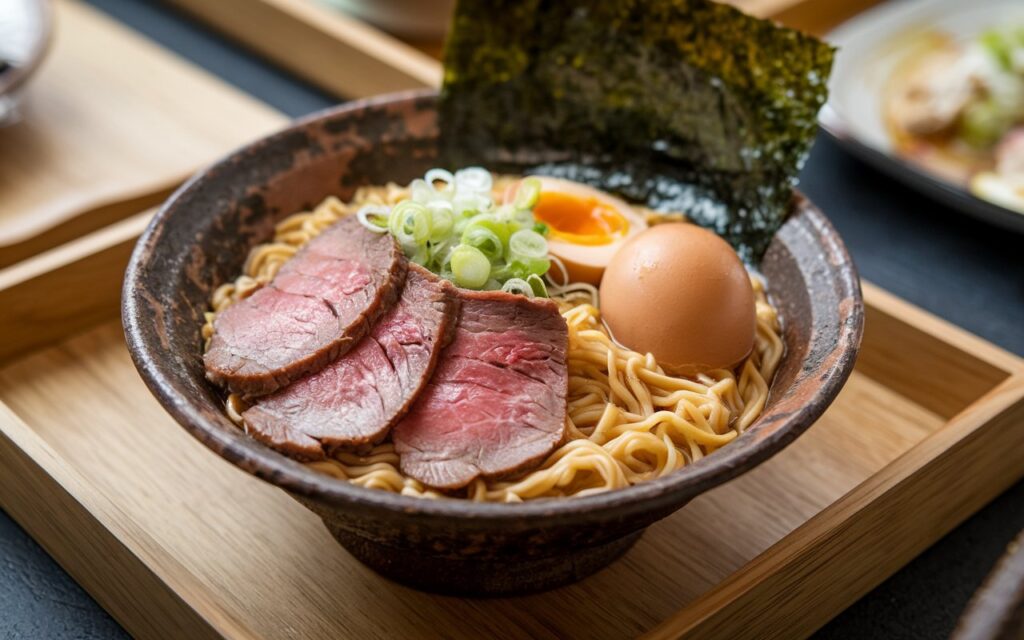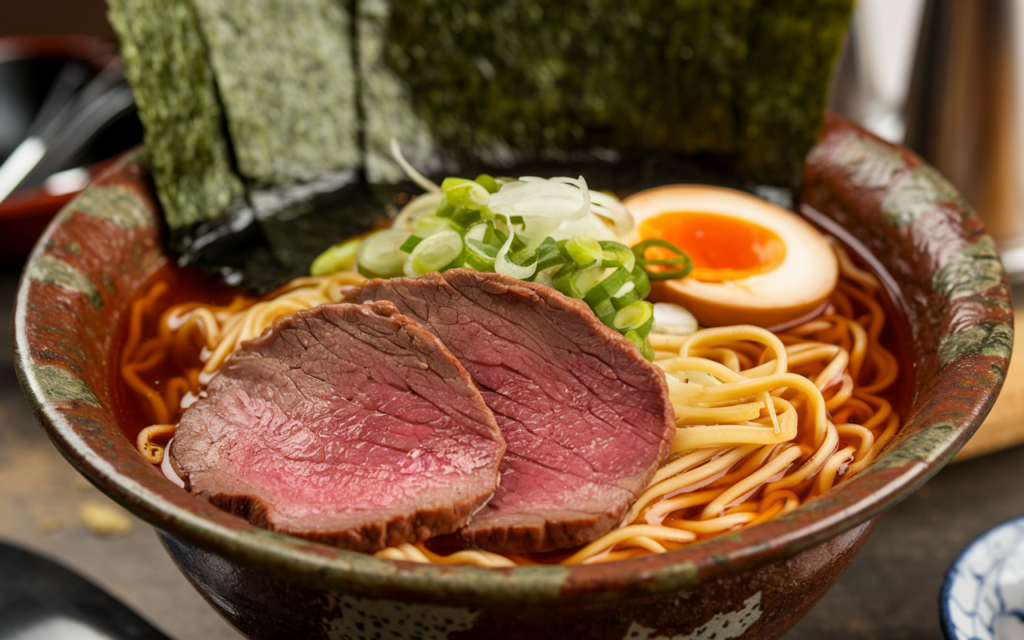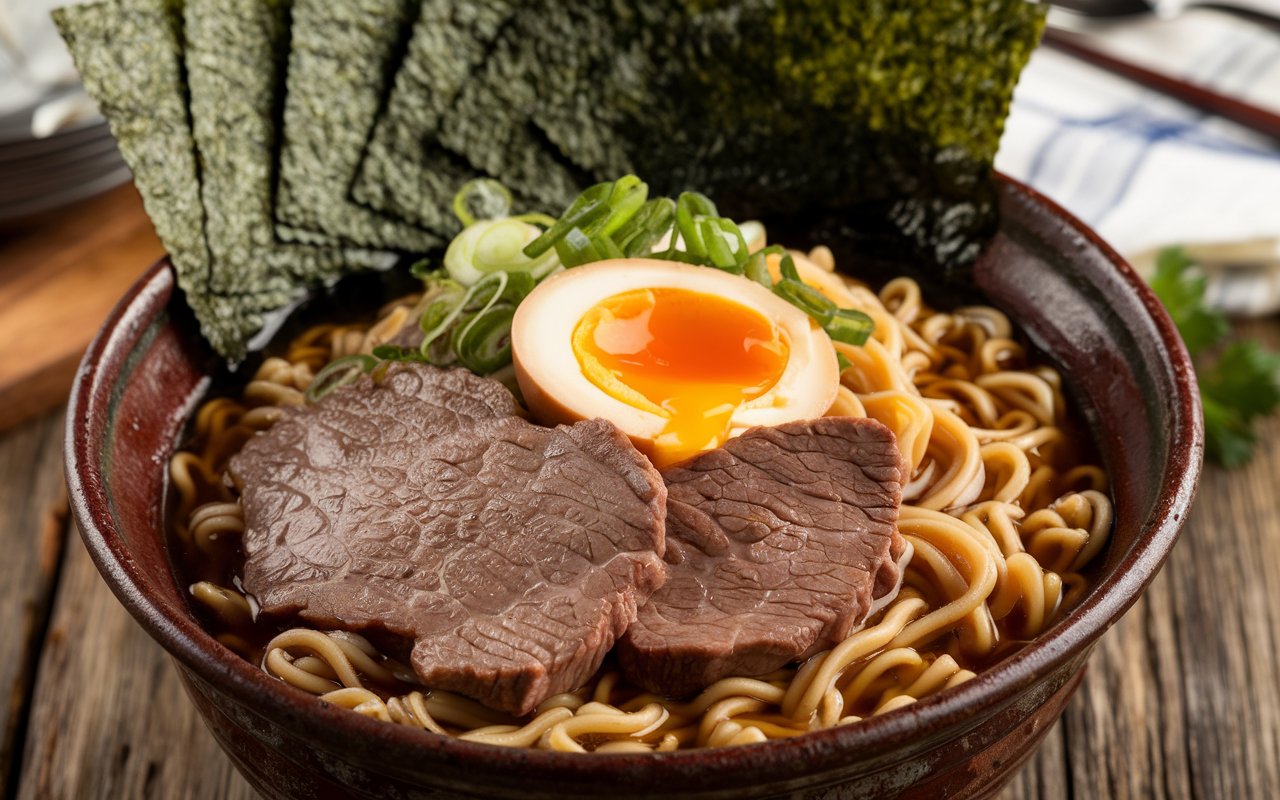Beef ramen noodle recipes are a perfect solution for those seeking comfort food with a twist. Whether you’re a ramen enthusiast or a novice cook, this guide provides you with step-by-step instructions to create flavorful ramen dishes. Packed with savory broth, tender beef, and chewy noodles, these recipes are sure to impress your taste buds. In addition, they’re highly customizable, allowing you to incorporate your favorite ingredients.
Explore creative ways to elevate your ramen experience with these tips and recipes. Before diving into the recipes, check out this guide to broth-making for additional insights into crafting the perfect base.
Why Choose Beef Ramen Noodles?
Ramen is not just a quick meal; it’s an art form. Using beef adds richness and depth to the dish, making it hearty and satisfying.
Benefits of Beef in Ramen
- Rich Flavor: Moreover, the marbling in beef significantly enhances the depth and richness of the broth, making it irresistible.
- Protein Boost: Additionally, beef is ideal for creating a balanced meal, offering a high-quality protein source to keep you energized.
- Versatile Cuts: In fact, you can use everything from tender steak strips to flavorful ground beef, ensuring flexibility in your recipes.
For tips on selecting the right cut, consider this comprehensive guide to beef cuts.
How to Make Beef Ramen Noodles Better
To create truly remarkable beef ramen noodle recipes, follow these techniques:
1. Build a Flavorful Broth
To begin, start with beef or bone broth as the foundation for a rich and hearty base. Furthermore, enhance the flavor by adding soy sauce, miso, and garlic, which contribute to an irresistible umami depth. In addition, consider incorporating a touch of ginger for extra warmth.
2. Choose Quality Noodles
Authentic ramen noodles are essential because they provide the perfect chewy texture. However, it’s crucial to avoid overcooking them, as this can lead to a mushy consistency. Instead, cook them just until al dente, ensuring they hold up well in the broth.
3. Perfect the Beef
To achieve tender and flavorful beef, initially select cuts like flank steak or sirloin. Moreover, marinating the beef with soy sauce, ginger, and sesame oil ensures maximum flavor absorption. Afterward, sear the beef briefly over high heat to lock in its juices.
4. Add Toppings
- Soft-boiled eggs: For creamy richness.
- Scallions: Add a fresh crunch.
- Seaweed (Nori): Enhances umami.
Beef Ramen Noodle Recipe #1: Classic Beef Ramen
Ingredients
- 2 cups beef broth
- 1 tbsp soy sauce
- 1 tsp sesame oil
- 200g ramen noodles
- 150g thinly sliced beef
- 1 boiled egg
- Toppings: scallions, sesame seeds, nori
Instructions
- Heat beef broth in a pot. Add soy sauce and sesame oil.
- Cook ramen noodles according to package instructions.
- Sear beef slices in a hot skillet for 1–2 minutes per side.
- Assemble noodles, beef, and broth in a bowl.
- Garnish with toppings and enjoy.
Beef Ramen Noodle Recipe #2: Spicy Miso Beef Ramen
Ingredients
- 2 tbsp miso paste
- 1 tsp chili oil
- 2 cups beef stock
- 150g ground beef
- 200g ramen noodles
- Toppings: bean sprouts, bok choy, green onions
Instructions
- Brown the ground beef in a skillet.
- In a pot, mix miso paste and chili oil into the beef stock. Bring to a simmer.
- Cook ramen noodles and assemble with broth, beef, and toppings.
What Sauce Goes With Beef Ramen?
Pair your beef ramen noodle recipes with these sauces:
- Soy-based Sauce: Adds umami depth.
- Spicy Chili Oil: For heat lovers.
- Sesame Dressing: Adds nutty richness.
Regional Variations of Beef Ramen
Beef ramen takes on different flavors and styles across the world, reflecting local ingredients and culinary traditions. Here’s a look at how beef ramen varies regionally:
Japanese Shoyu Beef Ramen
Shoyu (soy sauce) ramen is one of Japan’s most beloved variations. When paired with beef, it becomes a rich and savory dish perfect for a comforting meal.
- Broth: Made with soy sauce, dashi, and beef stock, offering a salty and slightly sweet flavor.
- Toppings: Thinly sliced beef, soft-boiled eggs (ajitama), nori (seaweed), and bamboo shoots (menma).
- Noodles: Thin, curly noodles to soak up the light yet flavorful broth.
Pro Tip: Use wagyu beef slices for an authentic Japanese touch.
Korean Spicy Beef Ramen
Korean cuisine adds a fiery twist to ramen by incorporating spicy and fermented flavors.
- Broth: Made with beef stock, gochujang (Korean chili paste), and kimchi for tangy heat.
- Toppings: Grilled bulgogi beef, sesame seeds, bean sprouts, and green onions.
- Noodles: Thicker noodles to balance the spice.
This variation is perfect for spice lovers who want bold and robust flavors.
Chinese Braised Beef Noodle Soup
Although not traditionally called ramen, Chinese beef noodle soup shares many similarities and has inspired ramen recipes worldwide.
- Broth: Made by slow-cooking beef shanks with soy sauce, star anise, ginger, and garlic for a deep, aromatic flavor.
- Toppings: Tender chunks of beef, pickled mustard greens, and bok choy.
- Noodles: Flat wheat noodles or hand-pulled noodles for a chewy texture.
This hearty version is a meal on its own, rich in both taste and tradition.
Thai-Inspired Beef Ramen
Thailand’s take on beef ramen incorporates sweet, sour, and spicy elements typical of Thai cuisine.
- Broth: Beef stock infused with lemongrass, galangal, and kaffir lime leaves.
- Toppings: Thinly sliced beef, bean sprouts, Thai basil, and a splash of lime juice.
- Noodles: Rice noodles or thin ramen noodles.
A drizzle of chili oil or a spoonful of Thai chili paste adds an extra kick.
Vietnamese-Style Beef Ramen (Pho-Inspired)
Pho and ramen collide in this creative fusion dish, blending the best of both worlds.
- Broth: Clear beef broth with hints of star anise, cinnamon, and clove.
- Toppings: Rare beef slices, fresh herbs, lime wedges, and bean sprouts.
- Noodles: Thin rice noodles, though ramen noodles can be used for a fusion twist.
This variation offers a lighter, fragrant option for ramen lovers.
Western Beef Ramen Fusion
In the West, beef ramen is often adapted with a creative twist, using ingredients like cheese, barbecue sauce, or even crispy onions.
- Broth: Rich beef stock combined with unconventional flavors like smoked paprika or Worcestershire sauce.
- Toppings: Grilled steak strips, fried onions, shredded cheese, or sautéed mushrooms.
- Noodles: Instant ramen noodles are a popular and convenient choice.
This variation highlights how ramen evolves when blended with Western culinary influences.
Tips for Cooking Beef Perfectly
Cooking beef for beef ramen noodle recipes requires a balance of technique and timing to ensure tender, flavorful meat. Follow these expert tips to achieve perfection every time:
1. Choose the Right Cut
- Best Cuts: Use tender cuts like sirloin, ribeye, flank steak, or tenderloin for quick cooking. For ground beef ramen, select lean or medium-fat ground beef.
- Budget-Friendly Options: Chuck or brisket can be used if slow-cooked in the broth for a rich flavor.
2. Marinate for Flavor and Tenderness
Marinating beef not only enhances its flavor but also tenderizes the meat. Here’s how to create the perfect marinade:
- Base Ingredients: Soy sauce, sesame oil, garlic, and ginger.
- Optional Add-Ons: Rice vinegar, honey, or a splash of chili oil for depth.
- Time: Marinate thin slices for at least 30 minutes; thicker cuts benefit from 2–4 hours.
3. Slice Thinly
- Technique: Always slice beef against the grain. This shortens muscle fibers, resulting in tender, easy-to-chew pieces.
- Thickness: Aim for slices about 1/8 inch thick for quick cooking.
Tip: Slightly freeze the beef for 10–15 minutes before slicing to make it easier to cut thinly.
4. Sear for Maximum Flavor
- High Heat: Initially, use a hot skillet or grill to sear the beef quickly. This way, you lock in juices and create a caramelized crust.
- Oil: For best results, use neutral oils like canola or vegetable oil, as they have a high smoke point and won’t burn easily.
- Cooking Time: Sear thin slices for 1–2 minutes per side. However, for thicker cuts, you’ll need to adjust the timing based on your desired doneness.
5. Avoid Overcooking
- Thin slices cook in seconds and should remain slightly pink to avoid dryness.
- If using ground beef, cook until just browned for a juicy texture.
6. Rest the Beef
- After cooking, allow the beef to rest for a few minutes before adding it to the ramen. This step lets the juices redistribute, ensuring moist and tender meat.
7. Infuse Beef Flavor into the Broth
For an extra punch of flavor:
- Brown beef bones or scraps in the pot before adding broth ingredients.
- Simmer the broth with the cooked beef to enhance its depth.
8. Use Proper Cooking Tools
- A sharp knife is essential for thin slicing.
- A cast-iron skillet or stainless steel pan is ideal for searing beef evenly.
- For slow-cooked cuts, use a Dutch oven or slow cooker.
9. Season Lightly
Remember that ramen broth is often salty and flavorful. Season beef lightly with salt and pepper or soy sauce to complement the broth, not overpower it.
10. Experiment with Cooking Methods
- Pan-Seared: Quick and effective for thin slices or ground beef.
- Grilled: Adds a smoky flavor to steak cuts.
- Slow-Cooked: Perfect for tougher cuts like brisket or chuck, creating melt-in-your-mouth texture.
How to Make Gluten-Free Beef Ramen
For those with gluten sensitivities or dietary restrictions, making a delicious gluten-free beef ramen is entirely possible. By substituting a few key ingredients, you can enjoy all the flavors and textures of traditional ramen without compromising on health or taste.

Step 1: Use Gluten-Free Noodles
The foundation of any ramen dish is the noodles. Replace traditional wheat-based ramen noodles with gluten-free options:
- Rice Noodles: Common in Asian dishes, they provide a smooth and chewy texture, making them an excellent choice for gluten-free ramen.
- Gluten-Free Ramen Noodles: Many brands now offer certified gluten-free ramen noodles made from rice or millet, which are convenient and widely available
- .Zucchini Noodles (Zoodles): As a low-carb and gluten-free alternative, they are ideal for those seeking a lighter and healthier option.
Pro Tip: Cook gluten-free noodles separately to prevent them from becoming mushy when added to the broth.
Step 2: Make a Gluten-Free Broth
Traditional ramen broths often contain soy sauce, which typically contains gluten. Here’s how to create a safe and flavorful broth:
- Base: Use beef stock or bone broth that is certified gluten-free.
- Seasoning Substitutes:
- Replace soy sauce with tamari (a gluten-free soy sauce alternative).
- Use coconut aminos for a slightly sweeter and milder flavor.
- Add garlic, ginger, and sesame oil for depth.
Step 3: Prepare the Beef
The beef is the star of the dish, and preparing it gluten-free is simple:
- Choose fresh cuts like flank steak, sirloin, or tenderloin.
- Marinate the beef in a mix of tamari, sesame oil, and garlic. Avoid pre-packaged marinades, as they may contain hidden gluten.
- Sear or grill the beef to perfection before slicing thinly.
Step 4: Select Gluten-Free Toppings
Toppings enhance the flavor and presentation of your ramen. Here are gluten-free options:
- Vegetables: For example, bok choy, spinach, mushrooms, and bean sprouts are naturally gluten-free, making them ideal additions.
- Eggs: Additionally, soft-boiled eggs add creaminess and richness, elevating the texture of the dish.
- Herbs and Garnishes: Moreover, scallions, cilantro, and sesame seeds are safe and flavorful choices, enhancing both taste and presentation.
- Crunchy Additions: Finally, fried shallots or garlic chips (ensure they’re gluten-free) provide a satisfying crunch, completing the dish with a delightful texture.
Step 5: Assemble Your Gluten-Free Ramen
Here’s how to put it all together:
- Start with your gluten-free noodles in a bowl.
- Pour the steaming hot gluten-free broth over the noodles.
- Arrange the beef slices and toppings on top.
- Finish with a drizzle of tamari or sesame oil for an extra burst of flavor.
Tips for Enhancing Your Gluten-Free Beef Ramen
- Add Heat: For those who love spice, include gluten-free chili paste or fresh chili slices for a spicy kick.Experiment with Citrus: In addition, a squeeze of lime can brighten the dish and enhance its flavor profile.Make it Creamy: To achieve a richer texture, add a splash of unsweetened coconut milk to the broth for a creamy twist.
Why Make Gluten-Free Beef Ramen?
This dish is perfect for:
- Health-Conscious Eaters: Gluten-free options are often lower in processed ingredients.
- Dietary Restrictions: Safe for people with celiac disease or gluten intolerance.
- Flavor Seekers: Retains the umami richness of traditional ramen while catering to specific needs.

FAQs About Beef Ramen Noodle Recipes
How to Make Beef Ramen Noodles Better?
To elevate your ramen, you should focus on quality ingredients and creative toppings. For instance, tender beef slices, perfectly cooked noodles, and fresh vegetables can significantly enhance the dish. Moreover, adding a soft-boiled egg or nori can take your ramen to the next level.
What Sauce Goes With Beef Ramen?
Soy-based or miso sauces are ideal for enhancing the beefy flavors. Additionally, you might consider adding a splash of chili oil for a spicy kick or sesame dressing for a nutty depth. Therefore, experimenting with different sauces can make your ramen more versatile.
What Kind of Beef Do You Use for Ramen?
When selecting beef, opt for tender cuts like sirloin or flank steak. In particular, sirloin provides a balance of tenderness and flavor. Alternatively, ground beef works well for spicier recipes or when you want a quicker cooking option. Consequently, the type of beef you choose will depend on your desired flavor profile.
Is Beef Ramen Noodles Healthy?
When made at home, beef ramen can indeed be nutritious. For example, using lean cuts of beef and fresh vegetables boosts the nutritional value. Furthermore, you can limit sodium in the broth by making it from scratch instead of using store-bought options. Ultimately, homemade ramen offers a healthier alternative to restaurant versions.

